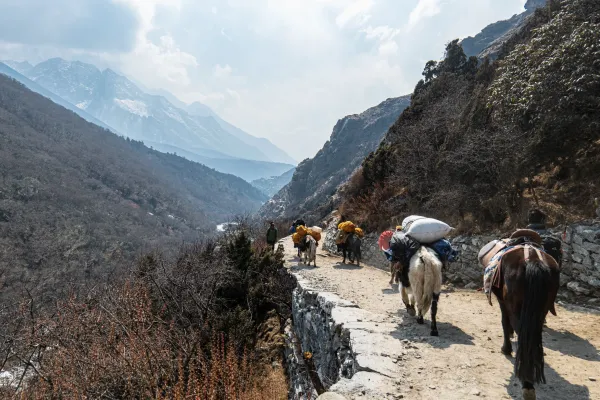
The Everest Base Camp Trek is one of the most exciting and unforgettable journeys in the Himalayas. This high-altitude trekking offers some of the greatest views of the world’s tallest mountain, Mount Everest, and long-preserved Tibetan Sherpa culture.
However, this one-of-a-kind experience comes along with shivering cold, especially during nights and early mornings, strong winds, and the risk of altitude sickness.
So, if you are thinking of setting on this unforgettable journey, then it is necessary that you have layered thick, warm clothes. A key ingredient in keeping yourself warm in such extreme conditions is your jacket. It can be crucial in determining the success of your trek.
Let’s discuss exactly what type of jacket is needed for the Everest Base Camp (EBC) Trek.
As you trek to higher elevation regions like Lobuche and Gorakshep during the Everest Base Camp Trek, the temperature can drop below freezing point. Even during peak trekking seasons, spring and autumn, the temperature at night can reach around -10°C.
You can just imagine how cold it is during winter. Likewise, around Kala Patthar, it is featured with a chilling gust of wind.
So, if you are not well equipped and have a warm jacket and other clothing like gloves, caps, and so on, you will be at risk of getting frostbite and hypothermia. So, a good jacket is required. Make sure it provides warmth and layering capability and is wind and waterproof.
Rather than relying on one thick, heavy jacket, it is wise that you follow a layering system. You can layer your clothes according to changing weather each day.
Base Layer (Thermal Innerwear)
It is the first line of defense against the cold. It would be better to have clothes made out of merino wool or synthetic thermals that are quick to wick sweat. Never go for cotton, as it produces a smell after sweating.
Mid-layer (Fleece or Softshell Jacket)
Make sure your mid-layer is comfortable, allowing mobility and breathability, and traps heat. It is ideal for day hikes at mid-altitude during the warm season.
Outer Layer (Down Jacket)
This is the most crucial part of layering for warmth. It must include a hood, be light (under 1 kg), and have wind resistance. Make sure it is rated to a temperature of -25°C and look for higher fill power (600-900); higher fill power means more warmth.
Rain Cover
A rain-resistant hard shell (Gore-Tex or similar) helps with sudden snow or drizzle, especially during monsoon, and doubles as a windbreaker.
If you are a regular trekker and prefer brand-new gear for hygiene or comfort, it is better to buy a good quality jacket in Kathmandu or from your country.
However, if you are not, renting a jacket is a good option. You can rent it from around Thamel, Kathmandu. Thamel is especially known for the trek and tour organizations and Nepali products.
You can visit any store selling trekking gear around Thamel and try it yourself. Then, once you are satisfied, you can make the payment and rent it for $1-$1.5 per day. So, for a 12-15 day EBC Trek itinerary, it comes to around $12-$20. However, the shop owners might ask for some deposit as collateral.
Tip: Inspect the jacket properly. Inspect zippers, hood, and inner linings well. Do not accept the jacket if it is damaged. A damaged piece can cause serious problems above 4000 meters.
Himalayan Masters helps you in the best way to find and rent the best jackets in Nepal for your Everest Base Camp Trek.
The seasons in the Himalayas can be divided into 4 categories: spring (March-May), monsoon (June-August), autumn (September-November), and winter (December-February).
So, layering clothes according to the season you are trekking is essential. You do not want to be trekking during spring with lots of heavy winter jackets or thin jackets during winter. It could be fatal.
A down jacket and light shell for spring trekking is enough. There might be occasional snow at high passes, for which a light shell might come in handy. Likewise, if you are trekking during autumn, you will need a down jacket and a windproof shell to tackle cold mornings.
Whereas a light down jacket and a rain shell are essential. Trekking in monsoons is quite challenging, so we do not recommend trekking in them. In contrast, trekkers in winter will need a down jacket with high fill power.
In addition, you will need an extra layer, crampons, and trekking poles if you are planning to trek during the inter.
Regardless of the season, a good down jacket is always necessary above Tengboche (3,860 m / 12,664 ft).
While trekking to Everest Base Camp is a thrilling and rewarding experience, you’ll be hiking in one of the world’s most extreme environments.
Being cold for hours every day can sap your energy, increase the risk of altitude sickness, and make even the most scenic days feel uncomfortable.
Investing in—or renting—the right jacket is one of the smartest things you can do for this trek. Don’t settle for a cheap knock-off or rely on an everyday winter coat. Choose a jacket designed for high-altitude, low-temperature conditions.